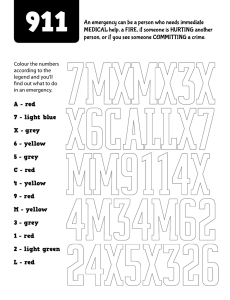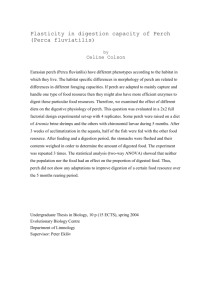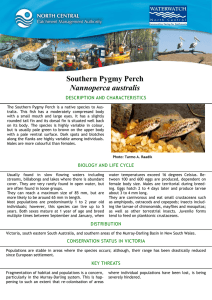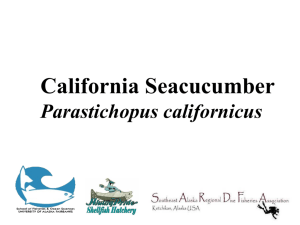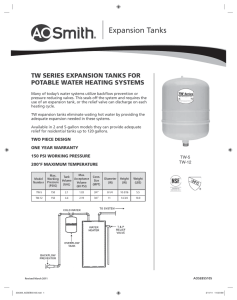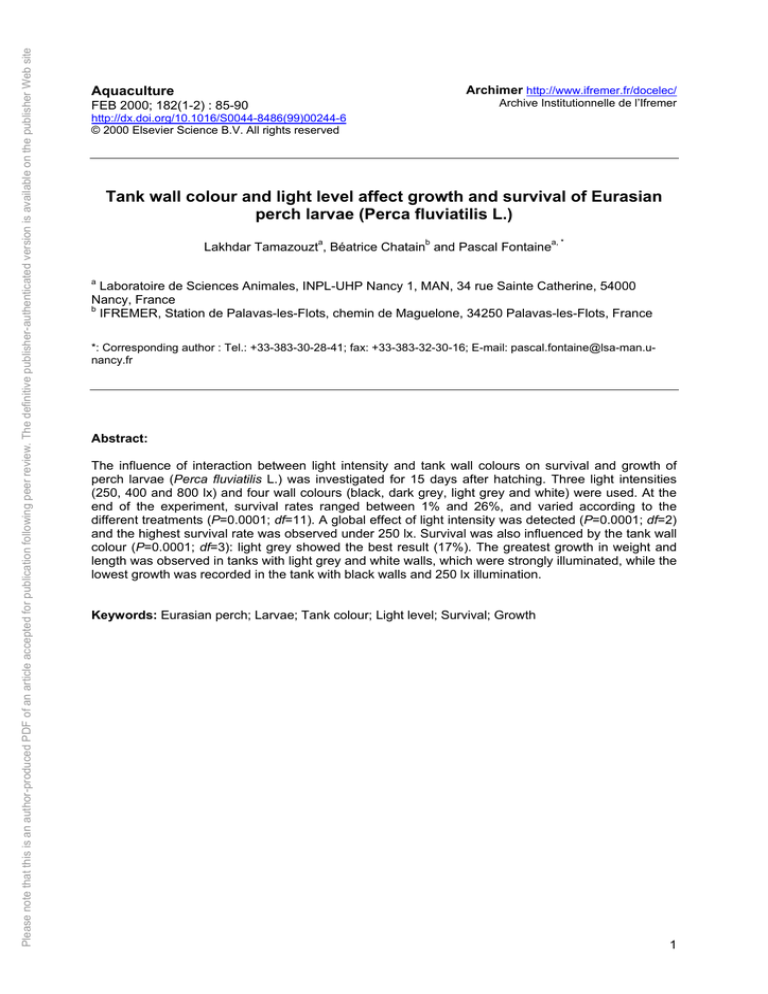
Please note that this is an author-produced PDF of an article accepted for publication following peer review. The definitive publisher-authenticated version is available on the publisher Web site
Archimer http://www.ifremer.fr/docelec/
Aquaculture
FEB 2000; 182(1-2) : 85-90
Archive Institutionnelle de l’Ifremer
http://dx.doi.org/10.1016/S0044-8486(99)00244-6
© 2000 Elsevier Science B.V. All rights reserved
Tank wall colour and light level affect growth and survival of Eurasian
perch larvae (Perca fluviatilis L.)
Lakhdar Tamazouzta, Béatrice Chatainb and Pascal Fontainea, *
a
Laboratoire de Sciences Animales, INPL-UHP Nancy 1, MAN, 34 rue Sainte Catherine, 54000
Nancy, France
b
IFREMER, Station de Palavas-les-Flots, chemin de Maguelone, 34250 Palavas-les-Flots, France
*: Corresponding author : Tel.: +33-383-30-28-41; fax: +33-383-32-30-16; E-mail: pascal.fontaine@lsa-man.unancy.fr
Abstract:
The influence of interaction between light intensity and tank wall colours on survival and growth of
perch larvae (Perca fluviatilis L.) was investigated for 15 days after hatching. Three light intensities
(250, 400 and 800 lx) and four wall colours (black, dark grey, light grey and white) were used. At the
end of the experiment, survival rates ranged between 1% and 26%, and varied according to the
different treatments (P=0.0001; df=11). A global effect of light intensity was detected (P=0.0001; df=2)
and the highest survival rate was observed under 250 lx. Survival was also influenced by the tank wall
colour (P=0.0001; df=3): light grey showed the best result (17%). The greatest growth in weight and
length was observed in tanks with light grey and white walls, which were strongly illuminated, while the
lowest growth was recorded in the tank with black walls and 250 lx illumination.
Keywords: Eurasian perch; Larvae; Tank colour; Light level; Survival; Growth
1
2
1. Introduction
The Eurasian perch Perca fluviatilis is a pelagic diurnal predator
(Dabrowski, 1982) whose vision is of vital importance in food detection. Within
the framework of perch culture development, optimization of the environmental
conditions, especially in larviculture, is necessary to facilitate the feeding
behavior of fish. Such a process involves, among others, the determination of the
best contrast between food particles and nearby environment. To improve visual
detection of food, the colour of tank walls (Corraza and Nickum, 1981; Hinshaw,
1986) and the lighting conditions (Ounaïs-Guschemann, 1989), such as light
spectral characteristics, ligth position or light intensity, are major factors.
The aim of the study was to establish whether light intensity and tank wall
colour influence survival and growth of Eurasian perch larvae raised under
controlled conditions and fed with a formulated diet.
2. Materials and methods
2.1. Fish and facilities
Ribbons of fertilized eggs were harvested in Lake Léman (INRA Thononles-Bains, France). Twelve thousand newly hatched larvae (average weight and
total length: 0.57 mg and 5 mm) were randomly distributed into 12
cylindroconical tanks of 100 l each (10 larvae/l) and reared for 15 days. The
internal wall of the tanks was either black, dark grey, light grey or white (3 tanks
per colour). Artificial illumination was provided by halogenic spotlights placed
above the centre of each tank. The different intensities (250, 400 and 800 lux;
Comp A 2010 Luxmeter, Chauvin-Arnaud) were obtained by adjusting the
distance (from 1 to 3 m) between the water surface and the spotlight. In order to
avoid any interference, each rearing unit was isolated with a black plastic cloth.
During the experimental period, a constant photoperiod (L :D 14 :10) was
maintained by an electronic clock. The experimental design is presented in table
1.
Table 1
Experimental design carried out during the 15 days rearing of Eurasian perch Perca fluviatilis larvae.
Light
intensity
Wall
colour
Tank
250 lux
black
1
dark
grey
2
light
grey
3
400 lux
white
black
4
5
dark
grey
6
light
grey
7
800 lux
white
black
8
9
dark
grey
10
light
grey
11
2.2. Water quality and feeding
Initially, all tanks were filled with tap-water. Every day, food excess was
siphoned and 20% of each unitary volume was renewed. Temperature, dissolved
oxygen and pH were measured every two days. Water temperature was
maintained between 19.7 and 21.6°C (mean: 20.2°C). In average, the dissolved
oxygen content was above 4 mg O2/l. pH fluctuated between 7.1 and 7.8 (mean :
white
12
3
7.3). N-NH4+and N-NO2- were checked twice a week. They were colorimetricaly
measured with indophenol blue and sulfanilamid methods, respectively. The
values always ranged between 0.01 and 1.45 mg N-NH4+/l (mean : 0.83) and
between 0.00 and 0.37 mg N-NO2-/l (mean : 0.23).
During the first 3 days, larvae were only fed with frozen zooplancton
(rotifers, copepods; Midisel Company, France). From day 4 to the end of the
experiment, larvae received 6 meals/day (9 :00, 10 :30, 12 :00, 13 :30, 15 :00 and
16 :30) composed of a formulated diet only (dry matter DM : 95%, crude protein :
50.7% DM, total lipids : 10.7%; Pican Company, France). The food, consisting of
80-125 µm particles (Tamazouzt et al., 1998), was yellow-brown. For each meal,
food was distributed in excess.
2.3. Survival, growth and data analysis
At day 0, 44 newly hatched larvae were sampled. Then, every two days
(from day 2 to day 12), about 10 larvae were caught in each tank. At the end of
the experiment, all larvae were counted for survival rate estimation and, according
to survival rates, a maximum of 20 larvae was removed from each tank. All
samples were conserved in a 10% formalin solution, then each fish was weighed
and measured individually.
Analysis of variance, relative to total weight and length measured on days 2,
4, 6, 8, 10, 12 and 15, were carried out. The variability of variances led us to
apply a two factor (wall colour and light intensity) non-parametric analysis
Friedmann rank sum test (Zar, 1984). The comparison between means was carried
out using the Tukey test. Survival rates were compared in a contingency table
(Dagnelie, 1975).
3. Results
3.1. Survival
At the end of the experiment, survival rates were comprised between 1 and
26%, and varied according to the different treatments ((2 = 602.05; P = 0.0001; df
= 11). A global effect of illumination was detected ((2 = 52.08; P = 0.0001; df =
2). The survival rates were higher (13%) among populations subjected to a 250
lux light intensity ((2 = 50.33; P = 0.0001; df = 2) than those subjected to 800 lux
(9%) or 400 lux (10%) ((2 = 1.94; P = 0.1636; df = 1). Survival was also clearly
influenced by the wall colour ((2 = 416.439 ; P = 0.0001 ; df = 3). Black walls
(3%) were clearly worse than other wall colours (13%) ((2 = 230.575 ; P =
0.0001 ; df = 1). Among the latter, differencies were also present ((2 = 158.591 ;
P = 0.0001 ; df = 2). Dark grey walls induced the lowest survival rate (7%) ((2 =
1135.919 ; P = 0.0001 ; df = 1), light grey ones the highest rate (17%) and white
walls an intermediate rate (13%) ((2 = 19.311 ; P = 0.0001 ; df = 1).
3.2. Growth
At the end of the experiment, the average weight and total length of fish
were respectively 2.5 mg and 8 mm. Until day 10, growth was slow and similar in
4
all batches (Table 2). From day 12, a weight difference appeared between the
lighter (white and light grey walls) and the darker (dark grey and black walls)
tanks. On day 12, a mean weight of 1.87 mg was recorded in lighter tanks versus
1.21 mg in darker tanks. Growth in length presented the same characteristics with
a 6.58 mm mean total length in lighter groups versus 6.45 mm in darker groups.
On day 15, the effects of walls colour were confirmed. The highest mean weight
was found with white walls (3.11 mg), the smallest one in black and dark grey
walls (2.05 mg) and the intermediate one in light grey walls (2.68 mg). The
average total length was also higher in lighter tanks (8.17 mm) than in darker
tanks (7.51 mm). Light intensity effects were only perceptible at D15 considering
the mean total length which corresponded to 7.90 mm (800 lux) versus 7.84 mm
(250 or 400 lux). The interaction between light intensity and wall colour was
significant. The greatest growth was observed in the lighter tanks, which were
strongly illuminated, while the lowest one was recorded in the darker tanks,
poorly illuminated.
Table 2
Main data provided by the non-parametric two factor analysis concerning the effects of light intensity (L) and
tank wall colours (C) on weight and length growth of Perca fluviatilis newly hatched larvae fed with a
formulated food during the first 15 days. The averages, classified in decreasing order, were compared using the
Tukey test. Df : degree of freedom ; (*) significant to a 5 % threshold; ___ homogenous groups.
Source
of variation
Age (d)
Variance
Df
H
Homogenous groups
Weight
Length
Weight
Length
Weight
Length
L
1263. 5
472.6
2
0.49
0.39
2
C
602.6
2965.2
3
0.64
2.45
LxC
775.6
724.3
6
1.42
0.60
L
794.0
1736.8
2
0.65
1.43
4
C
883.5
1372.2
3
0.73
1.13
LxC
1619.2
1068.2
6
1.34
0.88
L
627.5
789.8
2
0.52
0.65
6
C
1325.9
1798.9
3
1.09
1.48
LxC
1467.5
1160.1
6
1.21
0.96
L
185.6
274.5
2
0.15
0.22
8
C
495.9
3302.9
3
0.41
2.73
LxC
2043.9
574.9
6
1.69
0.47
L
4373.0
625.7
2
3.61
0.51
10
C
7050.3
3720.6
3
5.82
3.07
LxC
2606.6
151
6
2.15
0.12
L
4034.3
227.8
2
3.33
0.19
12
C
11881.4
10275.4
3
9.82*
8.5*
Lg W Dg B Lg W B Dg
LxC
4890.5
2875.2
6
4.04
2.37
L
43381.3
48254.6
2
1.1
11.8*
800 400 250
15
C
132048.0
100778.3
3
32.29 *
24.65*
W Lg Dg B W Lg Dg B
LxC
72165.64
58183.17
6
17.65 *
24.65*
@
@
@) : Below, treatments followed by the same letter are homogenous groups for the interaction L x C at day 15.
Weight : W400a W800a Lg400ab W250abc Lg800abc Dg800bcd Dg250cd Lg250d B800e B400f
Dg400fg B250g
Length : W800a Lg400a Lg800ab W400ab W250ab Dg250abc Dg800bc Lg250cd B800de B400def
Dg400ef B250f
5
4. Discussion
This short study showed that tanks with light colour walls (white or light
grey) associated to high illumination (400-800 lux) favoured growth and survival
of Perca fluviatilis larvae. Our results are different from those obtained by
Corazza and Nickum (1981) and Hinshaw (1986) respectively on larvae of
walleye Stizostedion vitreum and yellow perch Perca flavescens, two other
percids. They found that tanks with dark walls improved the prey perception
(rotifers, artemia nauplii). They also indicate that white walls highly attracted
larvae and inhibited their feeding behavior (mirror effect). In our case, light walls
associated with high illumination seems to induce a strong contrast between food
particles (brown-yellow) and tank wall and, consequently, improve food
perception (Ounaïs-Guschemann, 1989; Bristow and Summerfelt, 1994). The
larvae distribution in all the water columns confirms the adequacy of the
environmental conditions for perch larvae rearing, no mirror effect was observed.
Concerning light intensity effects, our results are in accordance with Dabrowski’s
observations (1982), who indicates that food consumption of Eurasian perch
larvae diminishes at the lowest light intensity. Similar observations were made
with yellow perch larvae by Hinshaw (1986), who remarks that weak illumination
associated with low contrasts induce a delay of 1 to 2 days in the initial food
intake. The effects of tank wall colours and light intensity are related to retinal
development (Guma’a, 1982).
For successful Eurasian perch larviculture, illumination such as 400-800
lux at the water surface and the use of tanks with light walls should be
recommended. However, our results must be confirmed by further experiments,
which will need a longer experimental period (3 to 4 weeks) and a more adapted
feeding protocole (using live prey such as artemia nauplii).
6
References
Bristow, B.T., Summerfelt, R.C., 1994. Performance of larval walleye cultures
intensively in clear and turbid water. J. World Aquacult. Soc. 25, 454-464.
Corraza, L., Nickum, J.G., 1981. Positive phototaxis during initial feeding stages of
walleye larvae. Rapp. P.-v. Réun. Cons. int. Explor. Mer 178: 492-494.
Dabrowski, K.R., 1982.The influence of ligth intensity on feeding of fish larvae and
fry: II. Rutilus rutilus (L) and Perca fluviatilis (L). Zool. Jb. Physiol. 86, 353360.
Dagnelie, P., 1975. Théorie et méthodes statistiques: Application agronomique, vol
II. Presses agronomiques, Gembloux, Belgium.
Guma’a, S.A., 1982. Retinal development and retinomotor responses in perch, Perca
fluviatilis. J. Fish Biol. 20, 611-618.
Hinshaw, M., 1986. Factors affecting survival and growth of larval and early juvenile
perch (Perca flavescens Mitchill). Ph.D. Thesis, North Carolina State University,
U.S.A..
Ounaïs-Guschemann, N., 1989. Définition d’un modèle d’élevage larvaire intensif
pour la dorade Sparus auratus. Thèse de doctorat, Université d’Aix-Marseille II,
France.
Tamazouzt, L., Leray, C., Escaffre, A.M., Terver, D., 1998. Effects of food particle
size on Perca fluviatilis larval growth. Aquat.sci. 60, 89-98.
Zar, J.H., 1984. Biostatistical analysis, 2nd ed., Northern Illinois University, U.S.A..

